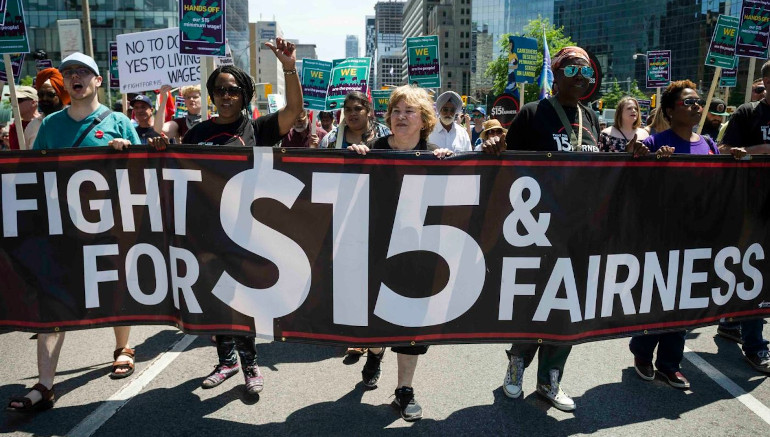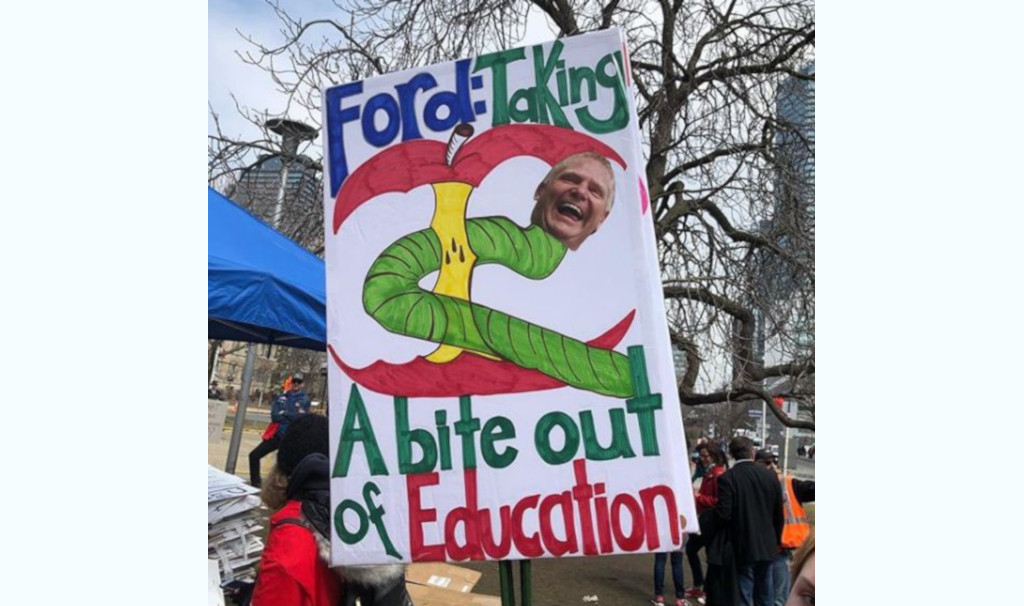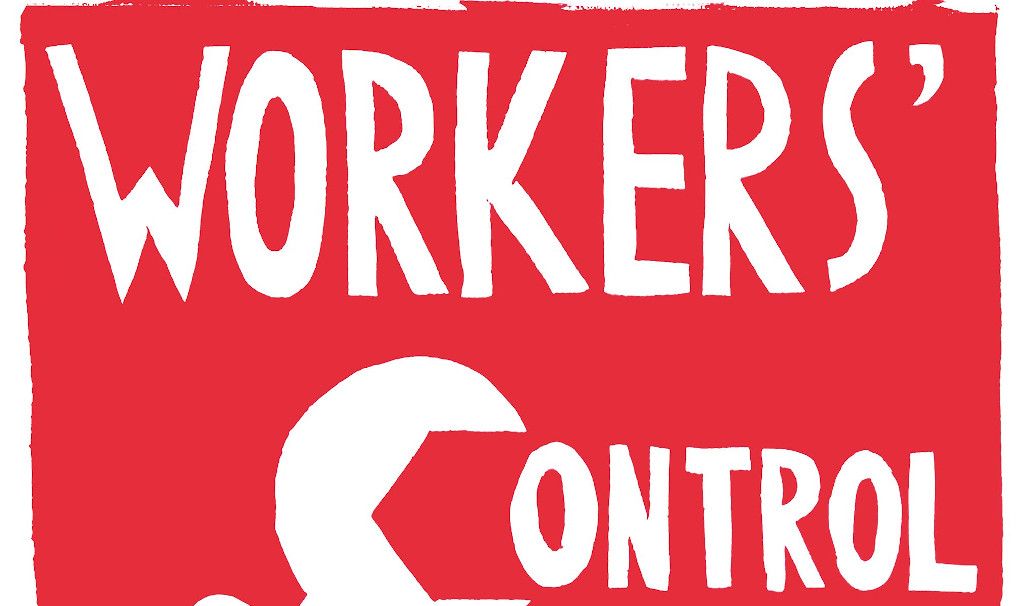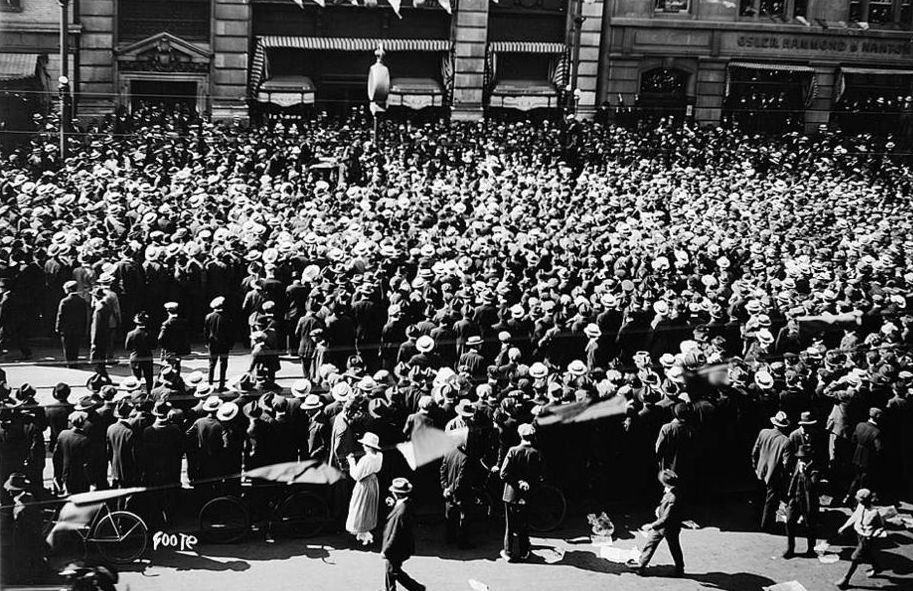Some people have been fooled into thinking that recent policy announcements by the Conservative government of Doug Ford have made him an advocate for working-class interests. Ontarians have seen a slew of announcements this fall about temp workers, gig workers, injured workers, being able to “disconnect from work” and the minimum wage. Ford is obviously worried about how workers view him. He’s right to be worried even if his party is on track to win next June’s election. According to a recent opinion poll, the Tories command 35 percent of decided voters, five points ahead of the Liberals at 30 percent. This is still a big drop form the 40.5 percent share of the vote Ford got in the 2018 election.
Ford Nation
Let’s go back to the Ford of 2018. He had honed his politics through his late, infamous, crack cocaine smoking brother Rob, Toronto Mayor from 2010 to 2014. Rob provided the launching pad for Doug to establish a political profile that would eventually extend beyond Toronto and appeal to the right-wing base in other parts of Ontario. Both Rob and Doug were the faces of “Ford Nation,” originally a TV show, where the two words came to represent the right-wing populism espoused by the Fords.
Ford shares several of the features of right-wing populist movements in many parts of the world:
- anti-elitism (but note Ford is a part of a family business that generates $100m in sales). In 2018 he wanted to fire the “six-million-dollar man,” the CEO of publicly owned Ontario Hydro, who was on a $6m salary
- an appeal to “the little guy,” eliminating government “waste”
- cutting taxes, and ending “the gravy train” (perks, expenses and trips of elected government officials)
- privatization of inefficient, “expensive” public services and playing up to the small and big business lobbies
Minimum wage, part one
In the early days of his government, Ford called the $15 minimum wage “a job killer.”
The former Liberal premier Kathleen Wynne increased the minimum wage at the start of 2018 to $14 an hour from the previous $11.40. Wynne’s plan was to rise it to $15 at the start of 2019 and then tie increases to inflation. Before that could happen, the newly-elected Ford scrapped the planned increase to $15. For good measure, he also did away with the two paid sick days that the Liberals had implemented.
In the context of Ford wanting to appear more worker friendly, his first revisitation of the minimum wage was an embarrassing flop. The October 2021 announcement of 10 cents an hour increase (yes, you read it correctly, 10 cents!) went down like a lead balloon. At the end of two days of work, that “increase” would pay for a small coffee at Tim Hortons. It was part of a piece of legislation, called in a subconsciously ironic way, the “Making Ontario Open for Business Act.” A journalist asked Labour Minister Monte McNaughton for his message to minimum wage workers about that 10-cent-an-hour increase. He did not address the pay hike directly but talked about Ontario’s labour shortage: “I don’t want to create an economy of minimum wage jobs. That’s why, for example, I’m encouraging people to go into the skilled trades.” The Ford government does indeed want to push young people into trades, but its focus is on grants to employers (up to $17,000 per person) rather than income support for workers doing the apprenticeship
Minimum wage, part two
One might be forgiven for thinking that Ford’s next iteration on the minimum wage marked a real conversion to worker solidarity. It came in the form of an announcement that the government will increase it from $14.35 to $15.00 on January 1, 2022. Welcome as the increase might be, the fact is that workers have lost out on $5,300 since Ford did away the Liberal increase scheduled for January 2019. If the minimum wage had risen with inflation from $15 in 2019 it would be $15.75 now.
So, while Ford’s change of heart is to be welcomed, in no way is it to be greeted as Ford becoming pro-worker. The real Doug Ford is the same one as three years ago, the one who scrapped the $1 hike and eliminated two paid sick days for Ontario workers as being necessary to help business. Despite the urgings of the health care community, Ford resisted reintroducing paid sick days for the longest time. When they finally conceded to public pressure “paid infectious disease emergency leave” (i.e. only COVID related) was the answer in the form of three days and on a temporary basis – it will stop at the end of this year.
The venue for the $15 announcement was at a Unifor meeting hall. Flanking Ford, and offering him support, were Unifor national president, Jerry Dias, and Warren “Smokey” Thomas, president of the public service union, OPSEU. Dias described the announcement as a victory. “Today is a good start,” he said while Thomas commented that “we have a government that is listening and doing positive things for working people.” By standing next to Ford, these union leaders, even if only providing qualified support, are enabling the embellishment of his so-called pro-worker credentials.
Bill 27 aka “Working for Workers Act”
The name gives it away – another blatant attempt to seem to be doing something for workers but, in reality, doing very little apart from extending the dressing of the window.
Disconnecting from work: This requires employers with 25 or more employees to have a written policy about employees disconnecting from their job at the end of each workday. The term means not engaging in work-related communications, including emails, phone calls, video calls so as to be free from the performance of work. Good policy but nothing is said about how it will be enforced.
Requiring washroom availability for delivery workers: Another good policy requiring business owners to allow delivery workers to use a company’s washroom if they are delivering or picking up items. However, there are enough exceptions that it won’t be difficult for an unsympathetic employer to deny the washroom facilities to a delivery worker. And again, nothing about enforcement.
Requiring the licensing of recruiters and the licensing of temporary help agencies: This is a positive step, as many migrant workers are exploited by recruitment agencies. However, enforcement is the key issue – meaning fines for non-compliance must be increased and there must be a significant security deposit for those seeking a license. The mechanisms for implementing this are missing in the Act.
Law and order
An indication that the spots on the Ford leopard haven’t changed comes from his playing the law-and-order card. Ford announced in mid-November a $75 million of extra funding for police justified by claims to tackle gun and gang activities. “We need more police officers on the ground. They’ve been stressed out, their budgets are always under review, always being chopped, we need to put money back in there,” he said. “We need to go out there aggressively after these gangs and hold them accountable. We need to put money back in there to have the women and men in uniform out there going after these gangs and guns.” Note that none of the new funding will be going to community outreach or grassroots organizations working to address the root cause of guns and gangs in the province. We would not play down the issue of gun violence that affects many working-class communities but Ford’s policy of putting more “boots on the ground” will not solve anything. As Toronto City Councillor, Josh Matlow, said, “Premier Ford should rather invest in finally addressing the roots of youth violence, creating affordable housing options, providing emotion-focused long-term care along with opportunities to age in place and fix the broken mental healthcare system, as a start.”
Last year the Ford government announced a $25 million increase in the police budget to hire 200 more Ontario Provincial Police officers following a report on mental health, occupational stress injuries and suicide by members of the force — a move many criticized as tone-deaf at a time of mounting calls to defund the police. The new recruits are meant to provide frontline officers with additional resources they need “to better protect communities, while safeguarding their mental health and well-being,” according to a government news release.
Bill 124, aka “Protecting a Sustainable Public Sector for Future Generations Act”
Like the “Working for Workers Act,” (see above) this is another laughably named piece of legislation from the Ford government. Introduced in 2019, the ostensible purpose of the Act is to “ensure that increases in public sector compensation reflect the fiscal situation of the province.” The Bill limits regular annual salary increases for a million public-sector workers in Ontario including nurses and teachers to one percent for each 12-month period. With inflation running at a two-decade high of 4.7 percent, you don’t have to be a math wiz to figure out that a one percent salary increase is not an increase. There has been nothing more evocative during COVID than photos of nurses after a long shift, eyes exhausted, faces marked by the masks and PPE they’ve worn for entire shifts. It was often nurses – when families were unable to be present in hospitals — who held the hands of COVID patients in their final moments.
Then Ford was happy to lead the chorus praising the heroism of nurses and other frontline workers – after all, it didn’t cost him anything. The nurses have rightly called Bill 124 a “slap in the face.” It is a more stinging slap when you consider that municipal workers, police and firefighters – no more put upon and heroic than nurses – are exempt from wage caps. Nursing unions say the bill is contributing to the nursing shortage in Ontario hospitals, as nurses are lured to the United States or other provinces. They also say it has increased the wage gap between men – who constitute the majority of police and firefighters – and women, who make up the largest proportion of nurses.
Food banks and gig workers
Increased food bank use can’t be laid exclusively at Ford’s door but holding down the minimum wage and public sector pay, alongside the lack of affordable housing, have certainly contributed to the problem. On November 15, the Toronto Star reported that “the pandemic has had a devastating impact on hunger in the city with more people relying on food banks to survive than ever before.” More worrisome, the report by two local food charities indicates the worst may be yet to come as COVID support programs come to an end. In 2021, Toronto food banks had 1.45 million visits, up 45 percent from 2020 and 1.5 times more than the previous record set after the 2008 financial crisis. New food bank clients increased 61 percent compared to the year prior and, for the first time, outnumber existing clients.
When it comes to gig workers, the Tories seem quite content to permit the systemic misclassification of this group of exploited workers. These workers do not have the benefit of the minimum wage, paid sick days, rights to form a union and other protections. And Doug Ford is not interested in doing anything about it but, a month ago, his labour minister did say “They deserve more, and we’re going to deliver for them.” Don’t hold your breath.
Ford still the friend of Business
The recent opinion poll (referred to at the start) found that those who have a favourable impression of Ford stood at 38 percent whereas 54 percent of Ontarians view him in an unfavourable light. That’s a significant fall from the 50 percent approval rate the Leger poll found in May.
From all of the above, it’s clear that Ford’s allegiance is still to business (big and small) and not to the working class. Any recent actions that favour working people can be explained either by public pressure having the effect of shaming him to go where his natural inclinations wouldn’t normally take him or by the provincial election looming in 2022 (or both).
Unfortunately, the labour movement is unwilling to lead a fight against Ford. It’s not just the union leaders who give cover to Ford. On the parliamentary front, the “left” opposition in the form of the NDP isn’t covering itself in glory either. They are running in third place with 25 percent support, compared to their vote in the 2018 election of 33.6 percent. The Liberals took 19 percent of the vote then and now they’re running at 30 percent. This is a worrying trend for the NDP, considering that the Liberal leader is virtually unknown and in 2018 they were reduced to seven seats in Ontario’s legislature. Ford, the wolf in sheep’s clothing, could be dispensed with in no time if the political and industrial wings of the labour movement came together to fight for a socialist program that included a minimum wage of $20 an hour, 10 permanent paid sick days, affordable housing and free public transit. That would be a start to the socialist transformation of society in Ontario, which would find an echo in the rest of Canada.




